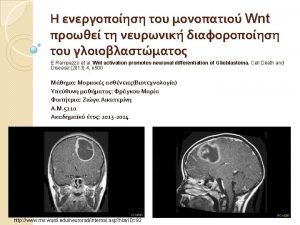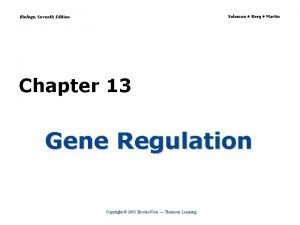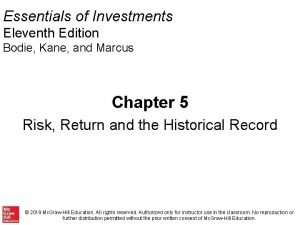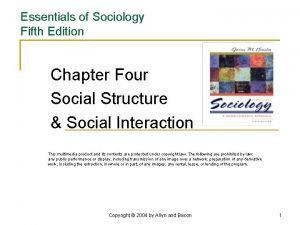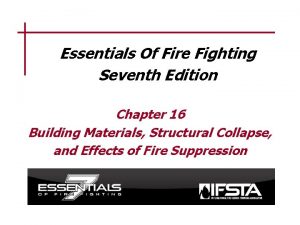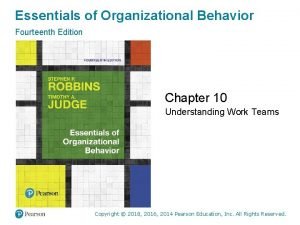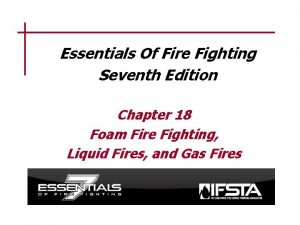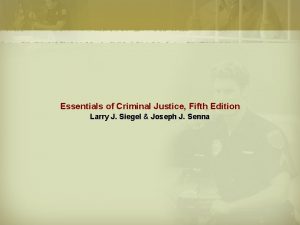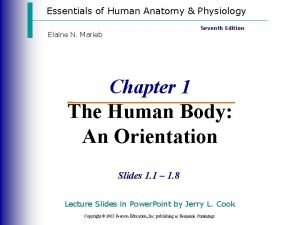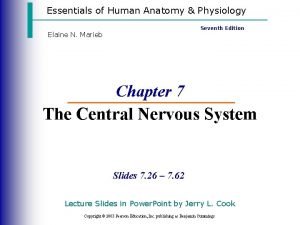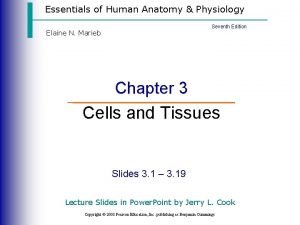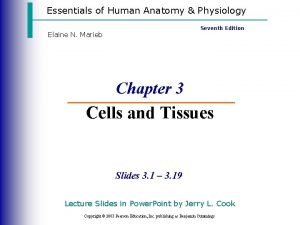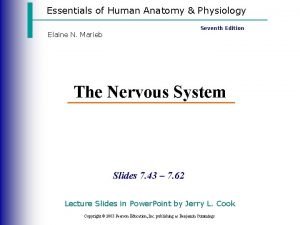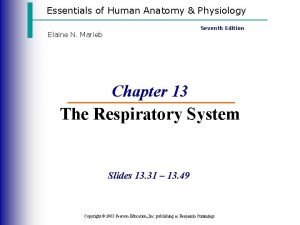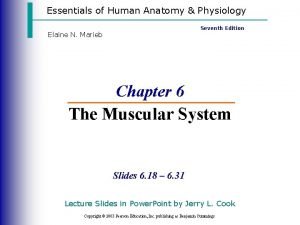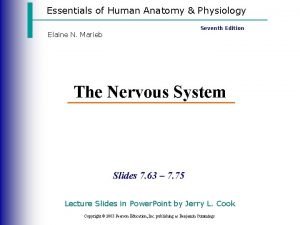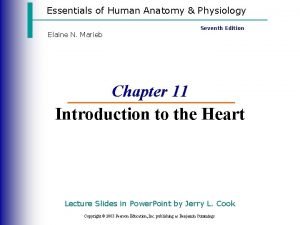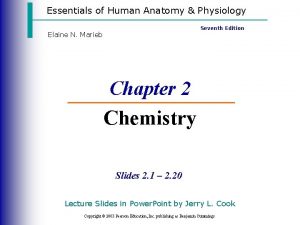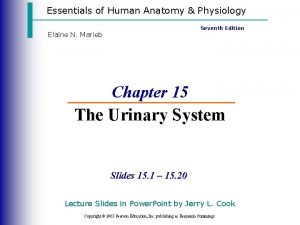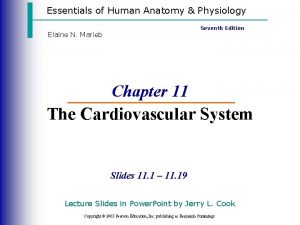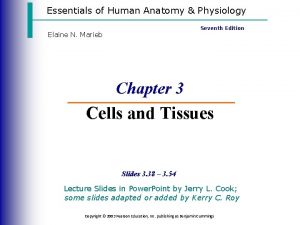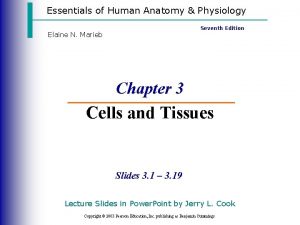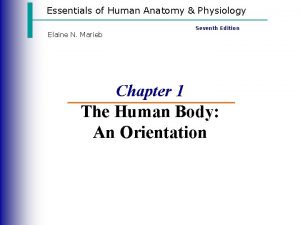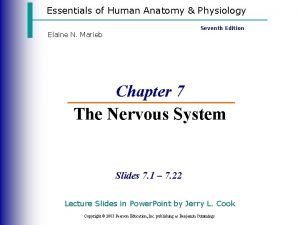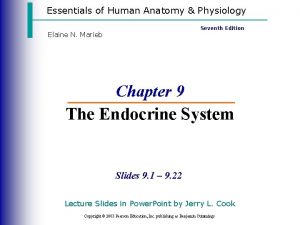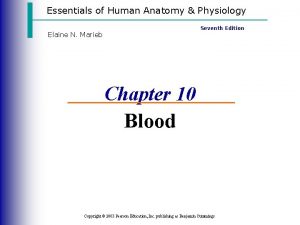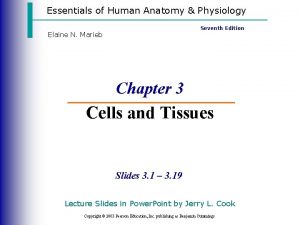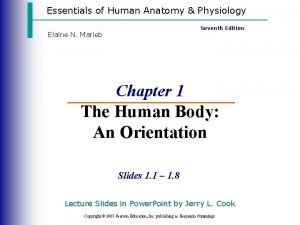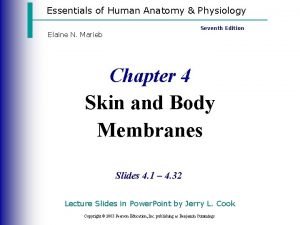Essentials of Human Anatomy Physiology Seventh Edition Elaine






























- Slides: 30

Essentials of Human Anatomy & Physiology Seventh Edition Elaine N. Marieb Chapter 13 The Respiratory System Structures Slides 13. 1 – 13. 30 Lecture Slides in Power. Point by Jerry L. Cook Copyright © 2003 Pearson Education, Inc. publishing as Benjamin Cummings

Organs of the Respiratory system · Nose · Pharynx · Larynx · Trachea · Bronchi · Lungs – alveoli Copyright © 2003 Pearson Education, Inc. publishing as Benjamin Cummings Figure 13. 1 Slide 13. 1

Function of the Respiratory System · Oversees gas exchanges between the blood and external environment · Exchange of gasses takes place within the lungs in the alveoli · Passageways to the lungs purify, warm, and humidify the incoming air Copyright © 2003 Pearson Education, Inc. publishing as Benjamin Cummings Slide 13. 2

The Nose · The only externally visible part of the respiratory system · Air enters the nose through the external nares (nostrils) · The interior of the nose consists of a nasal cavity divided by a nasal septum Copyright © 2003 Pearson Education, Inc. publishing as Benjamin Cummings Slide 13. 3 a

Upper Respiratory Tract Figure 13. 2 Copyright © 2003 Pearson Education, Inc. publishing as Benjamin Cummings Slide 13. 3 b

Anatomy of the Nasal Cavity · Olfactory receptors are located in the mucosa on the superior surface · The rest of the cavity is lined with respiratory mucosa · Moistens air · Traps incoming foreign particles Copyright © 2003 Pearson Education, Inc. publishing as Benjamin Cummings Slide 13. 4 a

Anatomy of the Nasal Cavity · Lateral walls have projections called conchae · Increases surface area · Increases air turbulence within the nasal cavity · The nasal cavity is separated from the oral cavity by the palate · Anterior hard palate (bone) · Posterior soft palate (muscle) Copyright © 2003 Pearson Education, Inc. publishing as Benjamin Cummings Slide 13. 4 b

Paranasal Sinuses · Cavities within bones surrounding the nasal cavity · Frontal bone · Sphenoid bone · Ethmoid bone · Maxillary bone Copyright © 2003 Pearson Education, Inc. publishing as Benjamin Cummings Slide 13. 5 a

Paranasal Sinuses · Function of the sinuses · Lighten the skull · Act as resonance chambers for speech · Produce mucus that drains into the nasal cavity Copyright © 2003 Pearson Education, Inc. publishing as Benjamin Cummings Slide 13. 5 b

Pharynx (Throat) · Muscular passage from nasal cavity to larynx · Three regions of the pharynx · Nasopharynx – superior region behind nasal cavity · Oropharynx – middle region behind mouth · Laryngopharynx – inferior region attached to larynx · The oropharynx and laryngopharynx are common passageways for air and food Copyright © 2003 Pearson Education, Inc. publishing as Benjamin Cummings Slide 13. 6

Structures of the Pharynx · Auditory tubes enter the nasopharynx · Tonsils of the pharynx · Pharyngeal tonsil (adenoids) in the nasopharynx · Palatine tonsils in the oropharynx · Lingual tonsils at the base of the tongue Copyright © 2003 Pearson Education, Inc. publishing as Benjamin Cummings Slide 13. 7

Larynx (Voice Box) · Routes air and food into proper channels · Plays a role in speech · Made of eight rigid hyaline cartilages and a spoon-shaped flap of elastic cartilage (epiglottis) Copyright © 2003 Pearson Education, Inc. publishing as Benjamin Cummings Slide 13. 8

Structures of the Larynx · Thyroid cartilage · Largest hyaline cartilage · Protrudes anteriorly (Adam’s apple) · Epiglottis · Superior opening of the larynx · Routes food to the larynx and air toward the trachea Copyright © 2003 Pearson Education, Inc. publishing as Benjamin Cummings Slide 13. 9 a

Structures of the Larynx · Vocal cords (vocal folds) · Vibrate with expelled air to create sound (speech) · Glottis – opening between vocal cords Copyright © 2003 Pearson Education, Inc. publishing as Benjamin Cummings Slide 13. 9 b

Trachea (Windpipe) · Connects larynx with bronchi · Lined with ciliated mucosa · Beat continuously in the opposite direction of incoming air · Expel mucus loaded with dust and other debris away from lungs · Walls are reinforced with C-shaped hyaline cartilage Copyright © 2003 Pearson Education, Inc. publishing as Benjamin Cummings Slide 13. 10

Primary Bronchi · Formed by division of the trachea · Enters the lung at the hilus (medial depression) · Right bronchus is wider, shorter, and straighter than left · Bronchi subdivide into smaller and smaller branches Copyright © 2003 Pearson Education, Inc. publishing as Benjamin Cummings Slide 13. 11

Lungs · Occupy most of the thoracic cavity · Apex is near the clavicle (superior portion) · Base rests on the diaphragm (inferior portion) · Each lung is divided into lobes by fissures · Left lung – two lobes · Right lung – three lobes Copyright © 2003 Pearson Education, Inc. publishing as Benjamin Cummings Slide 13. 12 a

Lungs Figure 13. 4 b Copyright © 2003 Pearson Education, Inc. publishing as Benjamin Cummings Slide 13. 12 b

Coverings of the Lungs · Pulmonary (visceral) pleura covers the lung surface · Parietal pleura lines the walls of the thoracic cavity · Pleural fluid fills the area between layers of pleura to allow gliding Copyright © 2003 Pearson Education, Inc. publishing as Benjamin Cummings Slide 13. 13

Respiratory Tree Divisions · Primary bronchi · Secondary bronchi · Tertiary bronchi · Bronchioli · Terminal bronchioli Copyright © 2003 Pearson Education, Inc. publishing as Benjamin Cummings Slide 13. 14

Bronchioles · Smallest branches of the bronchi Figure 13. 5 a Copyright © 2003 Pearson Education, Inc. publishing as Benjamin Cummings Slide 13. 15 a

Bronchioles · All but the smallest branches have reinforcing cartilage Figure 13. 5 a Copyright © 2003 Pearson Education, Inc. publishing as Benjamin Cummings Slide 13. 15 b

Bronchioles · Terminal bronchioles end in alveoli Figure 13. 5 a Copyright © 2003 Pearson Education, Inc. publishing as Benjamin Cummings Slide 13. 15 c

Respiratory Zone · Structures · Respiratory bronchioli · Alveolar duct · Alveoli · Site of gas exchange Copyright © 2003 Pearson Education, Inc. publishing as Benjamin Cummings Slide 13. 16

Alveoli · Structure of alveoli · Alveolar duct · Alveolar sac · Alveolus · Gas exchange takes place within the alveoli in the respiratory membrane Copyright © 2003 Pearson Education, Inc. publishing as Benjamin Cummings Slide 13. 17

Respiratory Membrane (Air-Blood Barrier) · Thin squamous epithelial layer lining alveolar walls · Pulmonary capillaries cover external surfaces of alveoli Copyright © 2003 Pearson Education, Inc. publishing as Benjamin Cummings Slide 13. 18 a

Respiratory Membrane (Air-Blood Barrier) Figure 13. 6 Copyright © 2003 Pearson Education, Inc. publishing as Benjamin Cummings Slide 13. 18 b

Gas Exchange · Gas crosses the respiratory membrane by diffusion · Oxygen enters the blood · Carbon dioxide enters the alveoli · Macrophages add protection · Surfactant coats gas-exposed alveolar surfaces Copyright © 2003 Pearson Education, Inc. publishing as Benjamin Cummings Slide 13. 19

External Respiration · Oxygen movement into the blood · The alveoli always has more oxygen than the blood · Oxygen moves by diffusion towards the area of lower concentration · Pulmonary capillary blood gains oxygen Copyright © 2003 Pearson Education, Inc. publishing as Benjamin Cummings Slide 13. 32 a

External Respiration · Carbon dioxide movement out of the blood · Blood returning from tissues has higher concentrations of carbon dioxide than air in the alveoli · Pulmonary capillary blood gives up carbon dioxide · Blood leaving the lungs is oxygen-rich and carbon dioxide-poor Copyright © 2003 Pearson Education, Inc. publishing as Benjamin Cummings Slide 13. 32 b
 Human anatomy and physiology seventh edition marieb
Human anatomy and physiology seventh edition marieb Uterus perimetrium
Uterus perimetrium Anatomy and physiology ninth edition
Anatomy and physiology ninth edition Waistline
Waistline Holes essential of human anatomy and physiology
Holes essential of human anatomy and physiology Chapter 1 introduction to human anatomy and physiology
Chapter 1 introduction to human anatomy and physiology Chapter 2 human reproductive anatomy and physiology
Chapter 2 human reproductive anatomy and physiology Chords rule in dbms
Chords rule in dbms Principle of information system
Principle of information system Molecular biology of the cell seventh edition
Molecular biology of the cell seventh edition Biology seventh edition
Biology seventh edition Human anatomy fifth edition
Human anatomy fifth edition Human anatomy fifth edition
Human anatomy fifth edition Network security essentials 5th edition
Network security essentials 5th edition Business essentials 12th edition chapter 1
Business essentials 12th edition chapter 1 Essentials of investments 11th edition
Essentials of investments 11th edition Business essentials 12th edition
Business essentials 12th edition Essentials of sociology 5th edition
Essentials of sociology 5th edition Firefighter essentials 7th edition
Firefighter essentials 7th edition Business essentials 12th edition
Business essentials 12th edition Essentials of management information systems
Essentials of management information systems Essentials of organizational behavior 14th edition
Essentials of organizational behavior 14th edition Fire fighting methods
Fire fighting methods Cryptographic systems are generically classified by
Cryptographic systems are generically classified by Criminal justice the essentials 5th edition
Criminal justice the essentials 5th edition Physiology of sport and exercise 5th edition
Physiology of sport and exercise 5th edition Lower respiratory structures
Lower respiratory structures Tattoo anatomy and physiology
Tattoo anatomy and physiology Science olympiad anatomy and physiology
Science olympiad anatomy and physiology Specialized stems examples
Specialized stems examples Anatomy and physiology of bone
Anatomy and physiology of bone









